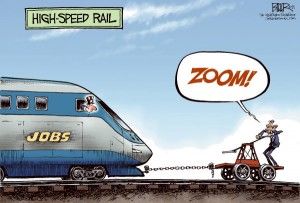Rail series: Medium-Speed Rail runs over High-Speed Rail
by CalWatchdog Staff | December 10, 2012 11:09 am
 [1]This is Part 1 of a series on Medium-Speed rail alternatives to California’s High-Speed Rail project. Click to read Part 1[2], Part 2[3], Part 3[4], Part 4[5], Part 5[6] and Part 6[7].
[1]This is Part 1 of a series on Medium-Speed rail alternatives to California’s High-Speed Rail project. Click to read Part 1[2], Part 2[3], Part 3[4], Part 4[5], Part 5[6] and Part 6[7].
Dec. 10, 2012
By Stan Brin
By now, everyone in California knows the voter-mandated High-Speed Rail project is a boondoggle. In fact, the HSR appears to be a boondoggle that actually exceeds the meaning of the word.
Not only will it cost as much as $80 billion to complete. The latest information from the United Kingdom[8] indicates that the HSR is unlikely to even reach the speeds that the voters were promised in Proposition 1A[9], which was passed in 2008.
Attempts to cruise above 200 mph produce a tremor strong enough to throw trains off their tracks. Called “Critical Track Velocity[10],” this phenomenon causes rails to vibrate and buckle dangerously. British engineers consider Critical Track Velocity to be the steel-on-steel equivalent of the infamous sound barrier that tore apart early jet fighters and still limits the speeds of commercial airliners.
CTV is a major reason why China won’t allow its high-speed trains to travel more than 185 mph. In Britain, engineers are working on the CTV problem, but they don’t expect a quick answer. Meanwhile, the French allow their TGV[11] (“Train à Grande Vitesse” which translates, oddly, as “Train to the Big Fastness”) to exceed 200 mph and keep their fingers crossed.
Alternatives?
That being said, are there any alternatives to mind-numbing hours behind the wheel or the humiliating mess at the major airports? The voters are clearly frustrated with crowded skies and highways designed in a time when the state’s population was less than a third its current size.
Perhaps there is a non-rail alternative. Here’s one suggestion that’s been bandied about that avoids roads, airports, and rails entirely:
A decade or two from now, those with a lot of money to burn may be able to take elevators up to high-rise heliports. There, they could board tilt-rotor aircraft similar to the Air Force’s V-22 Osprey[12]. These odd-looking contraptions would be able to fly them from San Francisco to Los Angeles, downtown to downtown, in 90 minutes or less. No tax money invested in infrastructure, no taking of private property, just private enterprise.
A tilt-rotor aircraft, flying from downtown high-rise to downtown high-rise, could work — for perhaps a few hundred daily custom-tailored members of the country-club set.
Especially those who could stand the ear-shattering noise and don’t mind paying a thousand bucks a ticket. Or maybe two thousand bucks a ticket. It’s impossible to say. So far, tilt-rotors are an exclusively military toy and aren’t certified for civilian use.
If it happens, I say, good for them. It’s their money.
Medium-Speed Rail
But for the rest of us, barring the development of beam-me-up teleportation, the only practical alternative to cars and airports appears to be what I call Medium-Speed Rail — conventional trains, running on conventional tracks, but at 90 to 135 mph.
That would be two to three times the current rail speed limit of around 45 mph, which is only a tad faster than trains powered by steam engines hauled around the horn on clipper ships 150 years ago.
What? You didn’t know that California’s trains only run at a speed of 45 mph? If you didn’t, you probably also didn’t know that the same trains can reach 80 mph with a free stretch of open track, or that conventional trains — not sleek, high tech streamlined thingies — operating in Pennsylvania cruise at 110 mph every day.
British steam engines reached 120 mph on conventional tracks back in the mid-1930s.
What does this mean? A steady 120 mph ride means a one-hour trip from Los Angeles to San Diego, downtown to downtown, certainly fast enough to compete with planes and automobiles. Most business travelers would prefer to have a leisurely breakfast in the dining car, read the paper, or unfold their laptops, and rent a car at the end of the line than waste two to three hours fighting boredom and traffic.
So why are California’s trains so slow?
The answer is simple: Our present system was designed and completed in the middle of the eighth decade of the 19th century, in an age of wood-fueled steam locomotives, while Ulysses S. Grant was president of the United States, and Sitting Bull and Crazy Horse were still fighting General Custer.
A Hopeless Relic
Rail infrastructure has been upgraded in places, of course, but mainly for the needs of unhurried, steady freight traffic, a sector that it handles well.
But for passengers, trains are a mixture of the bad, the obsolete and the completely missing. Bottlenecks force existing trains to operate at less than freeway speeds; and render it impossible to take a passenger train between Los Angeles and Bakersfield at all, with the exception of a single day per year.
I believe that if Californians cleared away 19th century cobwebs from their current system, the High-Speed Rail project wouldn’t be necessary, at least not for a long time. In fact, passenger service could be brought up to international standards without expending much more than a tenth of the $80 billion that the High-Speed Rail craziness would require.
All it requires is the will to be practical, and, well, capitalist.
Next: Part 2 will advance a real-world, capitalist solution.
- [Image]: http://www.calwatchdog.com/2012/12/10/railroad-series-medium-speed-rail-runs-over-high-speed-rail/cagle-cartoon-high-speed-rail/
- Part 1: http://www.calwatchdog.com/2012/12/10/railroad-series-medium-speed-rail-runs-over-high-speed-rail/
- Part 2: http://www.calwatchdog.com/2012/12/12/rail-series-a-capitalist-solution-for-california-train-travel/
- Part 3: http://www.calwatchdog.com/2012/12/13/rail-series-single-track-bottleneck-slows-ca-trains/
- Part 4: http://www.calwatchdog.com/2012/12/14/rail-series-medium-speed-train-tracking-costs-less-than-high-speed-rail/
- Part 5: http://www.calwatchdog.com/2012/12/17/rail-series-surmounting-the-tehachapi-barrier/
- Part 6: http://www.calwatchdog.com/2012/12/18/rail-series-who-will-own-it-who-will-pay-for-it/
- nformation from the United Kingdom: http://www.economist.com/node/21528263
- Proposition 1A: http://ballotpedia.org/wiki/index.php/California_Proposition_1A,_High-Speed_Rail_Act_(2008)
- Critical Track Velocity: http://www.telegraph.co.uk/news/uknews/road-and-rail-transport/9090727/High-speed-rail-link-at-risk-of-derailment-because-of-225mph-trains.html
- TGV: http://en.wikipedia.org/wiki/TGV
- V-22 Osprey: http://en.wikipedia.org/wiki/Bell_Boeing_V-22_Osprey
Source URL: https://calwatchdog.com/2012/12/10/railroad-series-medium-speed-rail-runs-over-high-speed-rail/